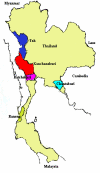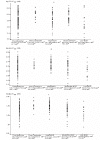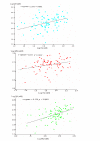In vitro antimalarial drug susceptibility in Thai border areas from 1998-2003
- PMID: 16060967
- PMCID: PMC1201168
- DOI: 10.1186/1475-2875-4-37
In vitro antimalarial drug susceptibility in Thai border areas from 1998-2003
Abstract
Background: The Thai-Myanmar and Thai-Cambodia borders have been historically linked with the emergence and spread of Plasmodium falciparum parasites resistant to antimalarial drugs. Indeed, the areas are often described as harbouring multi-drug resistant parasites. These areas of Thailand have experienced significant changes in antimalarial drug exposure patterns over the past decade. This study describes the in vitro antimalarial susceptibility patterns of 95 laboratory-adapted P. falciparum isolates, collected between 1998 and 2003.
Methods: Ninety five P. falciparum isolates were collected from five sites in Thailand between 1998 and 2003. After laboratory adaptation to in vitro culture, the susceptibility of these parasites to a range of established antimalarial drugs (chloroquine [CQ], mefloquine [MQ], quinine [QN] and dihydroartemisinin [DHA]) was determined by the isotopic microtest.
Results: Mefloquine (MQ) sensitivity remained poorest in areas previously described as MQ-resistant areas. Sensitivity to MQ of parasites from this area was significantly lower than those from areas reported to harbour moderate (p = 0.002) of low level MQ resistance (p = 000001). Importantly for all drugs tested, there was a considerable range in absolute parasite sensitivities. There was a weak, but statistically positive correlation between parasite sensitivity to CQ and sensitivity to both QN and MQ and a positive correlation between MQ and QN. In terms of geographical distribution, parasites from the Thai-Cambodia were tended to be less sensitive to all drugs tested compared to the Thai-Myanmar border. Parasite sensitivity to all drugs was stable over the 6-year collection period with the exception of QN.
Conclusion: This study highlights the high degree of variability in parasite drug sensitivity in Thailand. There were geographical differences in the pattern of resistance which might reflect differences in drug usage in each area. In contrast to many other studies there were weak, but statistically significant positive, correlations between sensitivity to CQ and sensitivity to MQ and QN. Over the six years of sample collection, parasite sensitivity appears to have stabilized to these drugs in these sites.
Figures



Similar articles
-
Drug resistance and in vitro susceptibility of Plasmodium falciparum in Thailand during 1988-2003.Korean J Parasitol. 2009 Jun;47(2):139-44. doi: 10.3347/kjp.2009.47.2.139. Epub 2009 May 27. Korean J Parasitol. 2009. PMID: 19488420 Free PMC article.
-
Monitoring of in vitro susceptibilities and molecular markers of resistance of Plasmodium falciparum isolates from Thai-Myanmar border to chloroquine, quinine, mefloquine and artesunate.Acta Trop. 2010 Feb;113(2):190-4. doi: 10.1016/j.actatropica.2009.10.016. Epub 2009 Oct 30. Acta Trop. 2010. PMID: 19879850
-
Four years' monitoring of in vitro sensitivity and candidate molecular markers of resistance of Plasmodium falciparum to artesunate-mefloquine combination in the Thai-Myanmar border.Malar J. 2014 Jan 15;13:23. doi: 10.1186/1475-2875-13-23. Malar J. 2014. PMID: 24423390 Free PMC article.
-
Drug resistant malaria on the Thai-Myanmar and Thai-Cambodian borders.Southeast Asian J Trop Med Public Health. 2001 Mar;32(1):41-9. Southeast Asian J Trop Med Public Health. 2001. PMID: 11485094 Review.
-
Monitoring antimalarial drug efficacy in the Greater Mekong Subregion: an overview of in vivo results from 2008 to 2010.Southeast Asian J Trop Med Public Health. 2013;44 Suppl 1:201-30; discussion 306-7. Southeast Asian J Trop Med Public Health. 2013. PMID: 24159833 Review.
Cited by
-
Molecular identification of two cestodes species parasitizing freshwater fishes in India.J Parasit Dis. 2019 Mar;43(1):59-65. doi: 10.1007/s12639-018-1058-z. Epub 2018 Dec 17. J Parasit Dis. 2019. PMID: 30956447 Free PMC article.
-
Effectiveness of quinine versus artemether-lumefantrine for treating uncomplicated falciparum malaria in Ugandan children: randomised trial.BMJ. 2009 Jul 21;339:b2763. doi: 10.1136/bmj.b2763. BMJ. 2009. PMID: 19622553 Free PMC article. Clinical Trial.
-
Progress towards malaria elimination in the Greater Mekong Subregion: perspectives from the World Health Organization.Malar J. 2024 Mar 1;23(1):64. doi: 10.1186/s12936-024-04851-z. Malar J. 2024. PMID: 38429807 Free PMC article.
-
Functional studies of Plasmodium falciparum dipeptidyl aminopeptidase I using small molecule inhibitors and active site probes.Chem Biol. 2010 Aug 27;17(8):808-19. doi: 10.1016/j.chembiol.2010.06.007. Chem Biol. 2010. PMID: 20797610 Free PMC article.
-
Drug resistance and in vitro susceptibility of Plasmodium falciparum in Thailand during 1988-2003.Korean J Parasitol. 2009 Jun;47(2):139-44. doi: 10.3347/kjp.2009.47.2.139. Epub 2009 May 27. Korean J Parasitol. 2009. PMID: 19488420 Free PMC article.
References
-
- Malaria-Division . Malaria Control Programme in Thailand. Malaria Division, Department of Communicable Disease Control (CDC) of the Ministry of Public Health, Thailand; 1998.
-
- World Health Organization . In vitro microtest (MARK II) for the assessment of the response of Plasmodium falciparum to chloroquine, mefloquine, quinine, sulfadoxine/pyrimentamine and amodiaquine. World Health Organization: Geneva, Switzerland; 1990.
Publication types
MeSH terms
Substances
LinkOut - more resources
Full Text Sources
Miscellaneous

